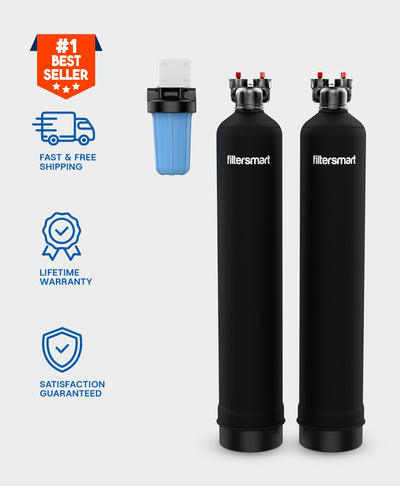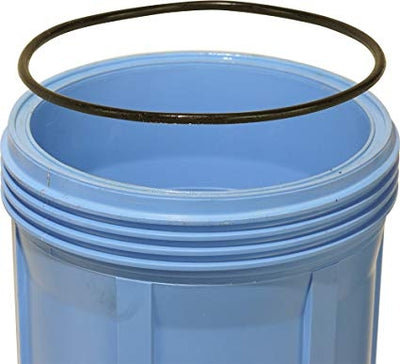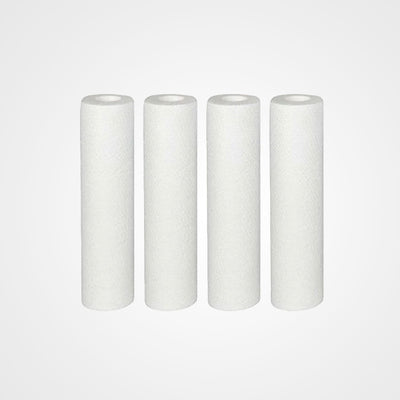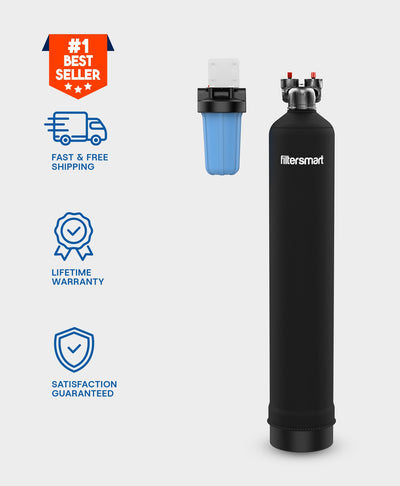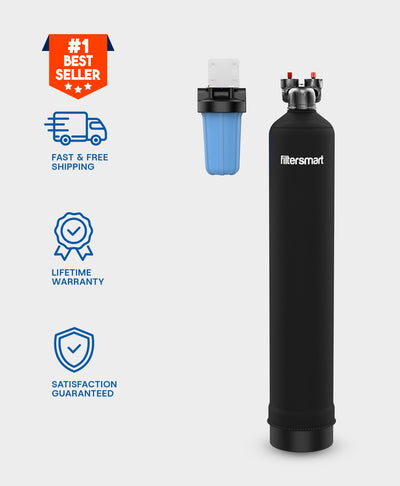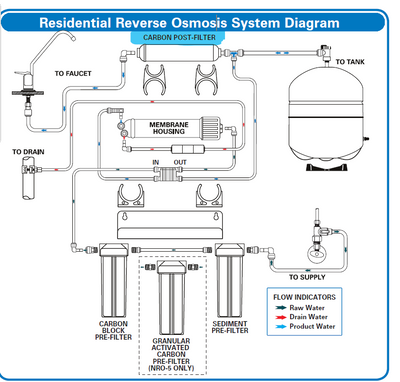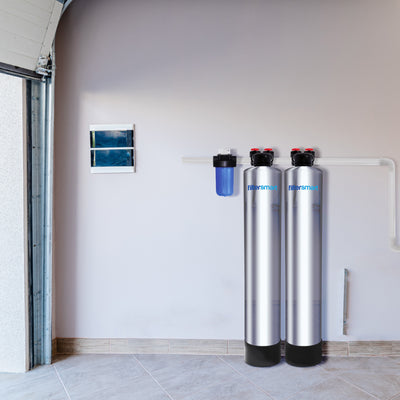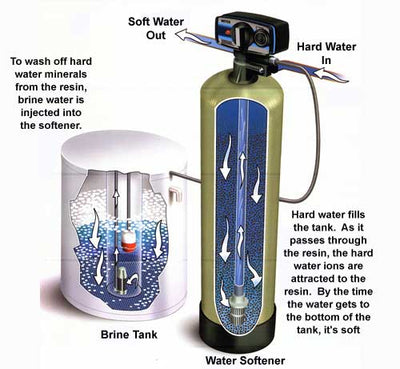Reverse osmosis removes unwanted chemical contaminants like sodium, chloride, chromium, and lead. It’s also extremely effective at removing viruses, like Hepatitis A and Rotavirus. The pore size for a reverse osmosis system is just 0.0001 micron. For comparison’s sake, a human hair is about 50 microns thick.
Combined with a pre and post filter, reverse osmosis is one of the most effective water purifiers around. So why not get it for your whole house?
Well, there are a few reasons, but first, let’s look at exactly how reverse osmosis works.
What is Reverse Osmosis?
Essentially, some sort of pressure pushes water through a semi-permeable membrane so that it goes from a more concentrated solution to a more dilute solution. This is the opposite of what occurs in nature. Think about a grape left out in the sun to become a raisin.
Water molecules inside the grape speed up and eventually exert so much pressure on the skin of the grape that the grape becomes completely dehydrated. That’s the process of osmosis.
In order to understand how water is filtered through reverse osmosis, picture the opposite. In many ways, it’s just another way of filtering water. However, the filter, in this case, is built out of a thin polyamide layer less than 200 nanomicrons wide. That’s why it’s able to remove so many unwanted contaminants.
That Sounds Great! So Why Don’t I Buy a Whole House Reverse Osmosis System?
One word: cost.For most residential applications, a whole house reverse osmosis system is ridiculously costly. Right off the bat, a whole house reverse osmosis system is going to set you back $12,000 to $20,000.
And, while it might be an added benefit to a prospective buyer, expensive appliances don’t necessarily increase a home’s value (particularly not to the tune of $10-20k). The condition and age of appliances are, of course, factors in the home’s official appraisal value, but your appraiser is not going to differentiate between a $20,000 whole house reverse osmosis system and a $1,200 whole house filtration and softener combination.
Besides, that’s not to mention the cost of maintenance with a whole house reverse osmosis system. It’s much more than any other system on the market.
Maintenance Costs of Whole House Reverse Osmosis
Reverse osmosis systems generate an absolutely absurd amount of wastewater. Water needs to be flushed back through the filter in order to regenerate it. We’ve seen some websites claim that, for every gallon of water produced, a reverse osmosis system wastes 7-8 gallons. The real figure is, thankfully, much lower.
Most estimates put the amount of wastewater produced per gallon of filtered water at 4 gallons to 1, meaning that you waste 4 gallons of water for every 1 gallon that you end up drinking. The worst part is that the wastewater produced by whole house reverse osmosis systems is sometimes well within safe water drinking standards.
So, unfortunately, a lot of systems are wasting water that’s completely harmless. And, when an area is undergoing a drought, no one wants to see someone throwing away a bunch of perfectly safe drinking water.
What if Your Whole House Reverse Osmosis System Becomes Illegal?
As drought becomes increasingly more and more common in certain parts of the continental United States -- particularly in the Rocky Mountain and West Coast areas -- lawmakers are beginning to target water filtration systems that waste a lot of water.
Naturally, if your whole house reverse osmosis system is using anywhere from three to four times the water as other households, your municipality might eventually come to the conclusion that you aren’t allowed to have a whole house reverse osmosis system at all.
The best-case scenario, if that happens, is that the state reimburses you for the cost of installing the system. The worst-case scenario, though (and the one that we find to be more likely), is that you’re simply out of luck. You’ll have to buy a system in line with the laws in your county.
What Alternatives Exist Outside of Whole House Reverse Osmosis?
Well, here at FilterSmart we sell whole house water filters and water conditioners that remove the same contaminants and viruses as whole house reverse osmosis. The biggest difference is that our systems don’t produce wastewater.
That means a few things. First, your water bill won’t quadruple overnight. Secondly, our systems aren’t going to be targeted by environmental activists any time soon. And, finally, they cost a lot less upfront than whole house reverse osmosis (and a whole lot less to maintain, but we’ll get to that in a second).
If you’re interested, please check out our store. We offer a 90 day free trial, so if you find that the system doesn’t work for you, just send it back.
Price Comparison: Whole House Reverse Osmosis versus Whole House Water Filters from FilterSmart
You already know that for every one gallon of water your reverse osmosis system produces, it also produces four gallons of wastewater, but how much will that set you back, really? If you’re still interested in buying one of those systems, how much will it cost altogether when compared with some more environmentally friendly alternatives?
First, let’s go with the mid-range figure for buying and installing the system. We established above that it would cost anywhere from $12-20k to install a whole house reverse osmosis system in your house. Let’s assume it costs $15k. Chances are that even if you buy a lower-end system or end up with a great deal, something will still go wrong with the installation since it’s much more complicated than your average water conditioner.
Next, let’s look at how much the average American spends on water per month. According to Move.org, that’s about $71/month. If your water demands don’t change, you’ll be using five times that amount (4 gallons of waste, 1 gallon of filtered), resulting in a monthly water bill of $355 (or an extra $284, however you want to look at it).
Altogether, you’ll spend ~$18,408 on your whole house reverse osmosis system in a year, and $3408/year after that.
Meanwhile, FilterSmart sells whole house water filters for as little as $1200. Let’s say you hire someone to professionally install the system, running you another $300. The only regular maintenance you’ll have to make is to replace the carbon, which costs about $250 every three to four months.
So, alternatively, in your first year, you’ll spend ~$2500 on a whole house water filtration system from FilterSmart, and $1000/year after that.
Conclusion: Should I Get a Whole House Reverse Osmosis System?
In our opinion, no. It just isn’t cost-effective. You’ll end up spending way too much money on your water bill -- and that’s not to mention the ridiculous upfront cost of the system. Now, you could be the one case in a million where it makes sense, but we doubt it. If you’re still interested in buying a whole house reverse osmosis system, you should look into the ones that repurpose the wastewater to other sections of the house, like your hose line. Otherwise, if you live in the West Coast or Rocky Mountains area, you’re going to run into trouble eventually.Instead, look into buying a FilterSmart whole house filter system. Our systems are built with pre-filters that remove large sediment, filters that remove smaller particles, and activated carbon that changes the way hard water interacts with surfaces. Check out the store here.







